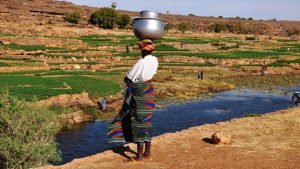By Brilé Anderson, The Sahel and West Africa Club/OECD
17 November 2022

The year’s COP27 is being called ‘Africa’s COP’. Even though African countries bear little responsibility for global emissions, they bear some of the harshest impacts. But far from being passive observers, they are active participants in the global climate agenda.
All 17 West African countries have submitted nationally determined contributions (NDCs) – their plans to cut emissions and adapt to climate change under the Paris Agreement. NDCs offer insights for participants at COP27 into the region’s ambition, financing needs and ability to implement.
After COP26 in Glasgow, countries agreed to revisit and reinforce their targets by the end of 2022. All West African countries have strengthened their targets since first submitting their NDCs. Sixteen of the 17 countries set economy-wide targets, as encouraged under the Paris Agreement. West African countries have expanded the scope of greenhouse gases or sectors covered, improved monitoring, reporting and verification, enhanced the quality of data underlying projections, and even raised mitigation targets.
Back-of-the-envelope calculations signal great potential for the region to reduce emissions, especially with additional financial and technical resources. Looking ahead, the region could boost the credibility of targets in future updates by enhancing the transparency of the models behind them, following the examples of Benin, Ghana, Guinea, Liberia and Togo. However, several countries in the region have also expressed the need for capacity building and better-quality data.
So far, finance mobilised under the Paris Agreement has fallen very short of the region’s needs. West African NDCs alone state that USD 221.2 to 279.7 billion is needed for mitigation and USD 61.4 to 88.8 billion for adaptation by 2030. However, only USD 83.3 billion was mobilised for developing countries in 2020. Of this, approximately 24% reached Africa as a whole, and even less for West African countries (approximately USD 6 million). In other words, West Africa has so far mobilised only 0.002% of the lower bound estimate of its needs. However, it is not only a matter of the total finance mobilised, but also the inability of these countries to access it under the existing financing architecture, especially when it comes to private finance. Yet nearly all NDCs mention the private sector as a potential source of finance. Mechanisms to access climate funds need to consider the challenges West Africa faces, especially its limited capacity to navigate the complex and highly technical processes for securing funding.
Concerning the region’s ability to implement NDCs, all countries show signs of horizontal co-ordination at the national level (e.g. inter-ministerial co-operation). However, there is rarely any mention of subnational actors (e.g. limited vertical integration), even though the Paris Agreement explicitly mentions their role. This is problematic because of the rapid urbanisation sweeping across the continent—an additional 900 million people will live in African cities by 2050 compared to 2015. This runs the risk of creating cities that lock in emissions for decades without considering climate objectives. Therefore, exploring ways to involve local actors in implementing the Paris Agreement will be essential for West Africa and across the continent.
Given inadequate financing and the exclusion of cities, it is unlikely that West Africa will meet its NDC targets. All countries cite the myriad of opportunities that the NDCs could provide for jobs, gender equity, health and well-being. The world will see if COP27 leads to concrete steps by West Africa, the entire continent and the rest of the world, to catalyse this transformation.
Read the West Africa and the global climate agenda report
Photo: Shutterstock

